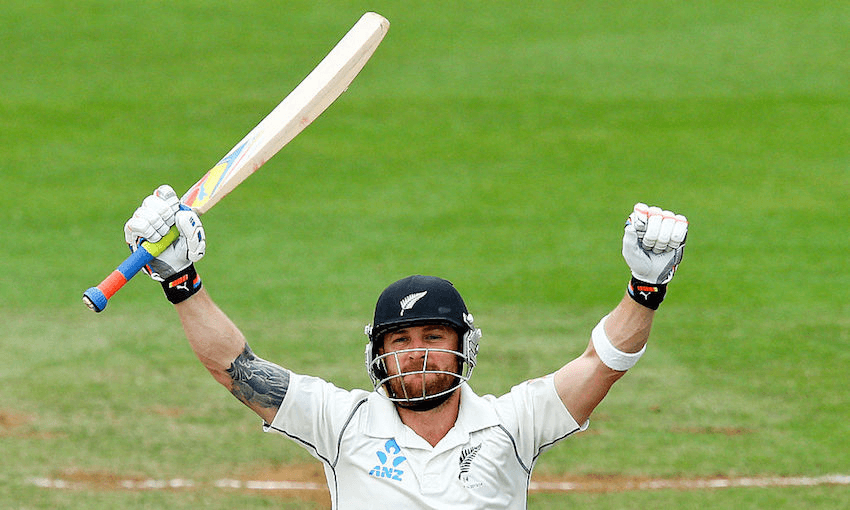Simon Day and Calum Henderson celebrate some iconic matches from the Black Caps’ back catalogue.
The only thing better than watching live cricket is watching classic cricket. It’s a sport that’s built on characters and narratives, and to be honest, four out of five games are just a bit disappointing. But with nostalgic games, you know for sure there’s going to be a tale behind it, whether it’s an epic personal milestone, an amazing finish, or a World Cup victory over a seemingly invincible nemesis while wearing a bright turquoise uniform. It all equals a viewing experience with many more layers than your average cricket match.
To accompany Sky Sport’s classic match package, The Spinoff is profiling three certified classics, pinpointing what makes these games special.
ICC World Cup at Cardiff, May 20, 1999
Australia 213/8
New Zealand 214/5 (45.2/50 ov)
New Zealand won by 5 wickets (with 28 balls remaining)
The 1999 New Zealand Cricket World Cup squad is one of the most underrated teams in our history. It was built in the most cliched New Zealand style ever – there were a couple of world-class players in Stephen Fleming and Chris Cairns, far too many all-rounders (in this game there were four and a half), some ridiculously slow bowlers who took wickets because they surprised batsmen with their true lack of pace in Chris Harris and Gavin Larsen, a genuine pace bowler who broke down a lot in Geoff Allott, and then, the most important of all, the battler – with extra points for being born overseas – Roger Twose.
Twose will always hold a special place in my heart. He played with a classic Duncan Fearnley bat. He had ridiculous facial hair. He was not athletically gifted but punched well above his weight in the outfield. It was perhaps because of his extra weight that he knew how to make an ordinary catch look miraculous. And he loved winning.
In the 10th match of the 1999 World Cup against the invincible Australians, he struck a match-winning 80 not out. He came together with Chris Cairns with New Zealand struggling at 49-4 in pursuit of just 214. Together they put on 148 for the fifth wicket. Where Cairns was flamboyant and powerful, Twose was gritty and brave. He outwilled some of the greatest bowlers of all time in Warne and McGrath. Where Cairns was effortlessly putting the Australian bowlers back over their heads for boundaries, Twose earned every run, slicing full tosses for four and diving to turn ones into twos. He had luck too.
In the Australian innings it was the surprise hero of the World Cup – Geoff Allott – who had set up the victory. After four stress fractures, Allott had been forced to adjust his action and choose swing over pace. And in the English conditions, his hooping left arm action was in fertile territory. His 20 wickets tied him with Shane Warne as the tournament’s leading wicket taker (and Warne played one more game). His 4 for 37 included a delicious in-swinging yorker that got Mark Waugh LBW.
The unsung hero of the 1999 World Cup was the team’s sartorial bravery. It was the last dance for the teal uniform, but the highlight of the team’s kit was the wet-look high-visibility full metallic silver strip. The sunglasses looked like they were from a 90s rap video, while the facial hair was something from the Seattle grunge movement. It was the peak of the New Zealand cricket team’s sartorial exploration, the team’s uniform has perpetually disappointed ever since.
Unfortunately, as was habit until 2015, the Black Caps lost in the semi finals. But getting a rare victory over the old canary gold foes is always worth celebrating.
– Simon Day
Sky Sport 2 is playing a selection of classic cricket matches over the coming weeks. Check the TV guide to find out what’s on.
2nd Test, India tour of New Zealand at Wellington, February 14-18, 2014
New Zealand 192 & 680/8d
India 438 & 166/3
Match drawn
“I wonder if the crowd will storm the field?” pondered Sky Sport commentator Simon Doull as Brendon McCullum approached 300 runs. If I’d been there I would have stormed the field. It was my destiny to be there. I was nearly there. But I fucked it up.
Two days earlier, watching from my flat in Auckland as Brendon McCullum and BJ Watling battled away at the Basin Reserve to keep New Zealand alive, I suddenly sensed something special was happening. When the fifth wicket fell early on day three with just 94 runs in reply to India’s 438, ESPN Cricinfo’s commentary read: “Innings win in sight for India.”
Had I not been so hungover on a lazy Sunday I probably would have turned off the TV at that point. But by the end of day three, McCullum was 114 not out and Watling with him on 54. I knew I had to get to the Basin Reserve as soon as possible.
I was due in Christchurch on February 21 for my sister-in-law’s wedding, so I decided to leave a few days early, certain something remarkable was going on. So just before the first ball on day four, I set off in my two-door turquoise Nissan Pulsar hatchback.
The car had always been reliable, but I’d let it fall into disrepair. Not just surface decay and McDonald’s bags building up in the passenger footwell, but proper negligence. The CV joints were the most worrisome. Whenever I turned a corner the wheel joint would clunk loudly. But on the straight it was fine. And something iconic was about to happen in Wellington, so I decided to risk it.
As I drove through the upper North Island, McCullum started slapping the Indian bowlers around the Basin Reserve and the Pulsar was travelling as smoothly as Richard Hadlee’s bowling action. Just out of Hamilton, McCullum brought up his 150 with a belligerent cover drive for four. A few kilometres before I got to Taupō, he reached 200 with a perfectly timed clip of his hips to the leg side boundary.
Out of Taupō, I skirted the lake on a stunning day with views across to Ruapehu and Ngāuruhoe as McCullum’s strike rate started climbing and my feeling that something important was happening started to crystallise. I was going to be there, in my favourite spot under the pōhutukawa on the bank to witness history. Then my CV joint started to rattle and crunch with the sound of metal on metal. My heart sank.
I turned back to Taupō and immediately found a mechanic. The sun was low in the sky as I explained my desperate situation. I needed to be in Wellington tonight. He said he’d do his best but wasn’t sure he could find the parts at this late stage in the day.
I went to the pub for a nervous beer and watched McCullum continue to pile on the runs. Watling was dismissed and Jimmy Neesham, who had waited eight and a half hours and 123 overs, joined his captain.
McCullum brought up his 250 with a thuggish six, pulling Mohammed Shami onto the grass banks of the Basin. And then the mechanic called. It was bad news. The repairs couldn’t be done until the morning.
I ordered another beer and felt my stomach clench as I watched the final overs of the day. McCullum ended on 281 not out. That night I barely slept, stimulated by a cocktail of adrenaline for Brendon and deep disappointment in myself.
The next morning around 10 I rolled out of Taupō with a new set of CV joints. With five hours of driving ahead of me it was only then that I finally acknowledged I wouldn’t be a part of the historic moment.
Bryan Waddle guided me through McCullum’s next 17 runs as I passed through Tūrangi and onto the desert road, worried I was going to lose reception. On 298, Zaheer Khan ran into bowl and McCullum cut him through the gap in backward point for four. Bryan Waddle’s voice shot up an octave. “They’re on their feet at the Basin Reserve,” he squealed. The crowd of public servants and school kids who’d all wagged the morning rose together in ovation for this flawed hero of New Zealand cricket.
I was meant to be there. I was meant to lead the crowd onto the field like my six-year-old self had seen happen for Martin Crowe in the opening match of the 1992 World Cup. But instead I was listening on the radio somewhere in the middle of the North Island. I had no one to blame but myself. Tears streamed down my face. Tears of joy. And tears of heartbreak.
In an interview after the match, when McCullum was asked if those were tears in his eyes as he bathed in the applause after becoming the first Kiwi to reach 300, he laughed: “I’m from South Dunedin, mate.”
– Simon Day
4th ODI, England tour of New Zealand at Napier, February 20, 2008
England 340/6
New Zealand 340/7 (50 ov)
Match tied
Will we ever see a more exciting pair of opening batsmen than Brendon McCullum and Jesse Ryder? McCullum wandering all around the crease, constantly innovating and infuriating bowlers; Ryder just standing still and smashing everything like cricket’s version of Neo in The Matrix.
He wallops one delivery from Jimmy Anderson straight back over his head and high into the McLean Park stands. “Holy cow!” cries Martin Crowe in the Sky Sport commentary box. This is great cricket.
This is New Zealand vs England, game four of the National Bank ODI series, 2008. When Vivaldi’s Summer was the soundtrack for the international cricket season.
The Black Caps lead the five-game series 2-1. Daniel Vettori has won the toss and chosen to bowl. Iain O’Brien has come into the side for his ODI debut.
He is taken to the cleaners by the England openers. To be fair, the entire New Zealand pace attack – Martin, Mills, O’Brien and Oram – cop a fair bit of punishment as Alastair Cook and Phil Mustard pile on 158 for the first wicket. “This is the best day of Phil Mustard’s life,” announces Martin Crowe after the wicketkeeper-batsman hits another six.
He makes 83 before holing out to Jacob Oram on the boundary, undone by the part-time bowling of Jesse Ryder. The very next ball, Ryder clean bowls Alastair Cook. “He really is outstanding,” gushes Crowe. “Make him prime minister.”
He could take it a step too far sometimes, couldn’t he, Martin Crowe. But man I miss his commentary – no one else can proclaim “oh my giddy aunt” quite like he does at the end of this match.
So much else will happen before then, though. The worst drop of Brendon McCullum’s wicketkeeping career, an awesome diving catch from “Two-Metre” Peter Fulton. A freak runout from Kevin Pietersen, a six onto the roof from Paul Collingwood. Ross Taylor slog-sweeping, Billy Bowden in full flight.
Sometimes games of cricket get a certain feeling about them, as if suddenly all bets are off, anything is possible. Like maybe Jamie How could just come out of nowhere to hit one of New Zealand’s great limited overs innings, that sort of thing. From Napier, on a Wednesday in 2008, this is one of those games.
– Calum Henderson
Sky Sport 2 is playing a selection of classic cricket matches over the coming weeks. Check the TV guide to find out what’s on.

